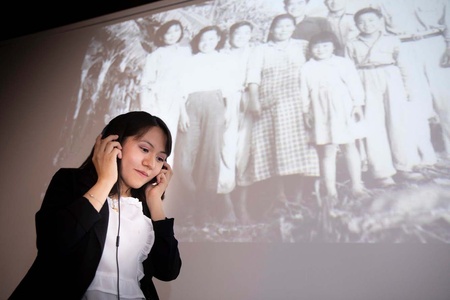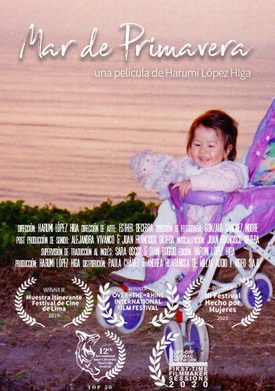Harumi López Higa is only 26 years old, but has a long life story that she has been able to summarize in a short film that has brought her early but unanimous recognition. The video Spring Sea , which refers to the meaning of its name, was selected among the 50 best short films at the 12th International Inter University Short Film Festival Bangladesh 2020. And it has continued to receive distinctions.
It has been a short path, in time, but intense both for its filming and its journey through festivals: it participated in the Traveling Show of the Lima Film Festival 2019, in the official selection of the Lift Off Global Network: First-Time Filmmaker Sessions August 2020 , from the United Kingdom, and at the Over-the-Rhine International Film Festival, from Ohio, United States, where it won the award for best university short film in 2021.
His story is a very personal story that has had a recent stop in the Nikkei Film Festival short film series, at the Cineclub de Lambayeque, with the support of Futari Proyectos, where his film, which could be seen in person, continues to move the public with his autobiographical story: his childhood and confrontation with the diagnosis of “flexed right knee” that marked those first years of growth and maturation.

Value and value
Three surgical interventions when she was a child, rehabilitation therapies and other difficulties have helped Harumi not only to tell the story that was a university project when she studied Audiovisual Communication at the Pontifical Catholic University of Peru, but also for her life. “It helped me value and be grateful,” she says, clarifying that her desire was not to be seen as a victim or martyr.
“It was a part of my life that I didn't recognize until doing that work, even though it was something I needed to share. There was a need in me to tell it, but I was afraid,” she says, adding that she also values the team that helped her make this 19-minute short. “It was very emotionally exhausting, having to delve into everything that happened to me, what I was experiencing… I was very vulnerable.”
Harumi remembers that the presentation of her university work took place at the Place of Memory (LUM). He invited his parents, uncles and cousins who had not seen any of the documentary. “I edited it at dawn, with headphones, so they wouldn't notice.” Even though they knew what she had been through, seeing it on screen was different. “It was exciting to share that experience with them and with many people I didn't know who came up to me to say hello.”
Nikkei women
Harumi was not interested in cinema until shortly before she began studying it. In recent years at the Nikkei La Victoria school he liked architecture and during the first years of university he dedicated himself to radio. “I saw cinema as something difficult because in Peru there is no industry as such.” Short films fill an artistic need and a personal facet: that of telling stories with a message that connects with another person.
When the artist Haroldo Higa invited her to be part of the Third Nikkei Young Art Salon 2019 , Harumi thought of another family story: that of the Nikkei women in her family. Four women from different generations who help tell experiences of migration, discrimination and inequality. Stories of bravery that have been portrayed by an audiovisual director, an expert in the true story. “When I was ten years old I made videos with my friends and edited them, but I didn't imagine that could become a career.”
Yonsei was presented in the gallery of the Peruvian Japanese Cultural Center, thanks to the fact that Haroldo saw in Harumi “something that I didn't know I had.” After almost eight months working with other Nikkei artists when he had just finished university, the short film was exhibited within an installation. “The experiences of my great-grandmother and my obachan came out. Not much is known about what Nikkei women did, there was very little information, so I took the opportunity to tell that.”
Feminine cinema
Talía Vidal and Jimena Mora direct Futari Proyectos , which seeks to disseminate Asian cinema through research, teaching and cultural management. “Our bond with Japan is born from a sensitivity that we curiously share,” they explain. They have focused on films made by Asian female directors and Nikkei films in Peru. “It seemed natural to us to approach the Nikkei community and we decided to start at home.”
Thus they discovered that there are many young people who, using audiovisual resources, seek to discuss, reflect and place their impressions on a fluid identity, which keeps elements of the traditions of their ancestors. In December 2020 they held the virtual exhibition “A Look at Nikkei Cinema” and this year they received the invitation from the Lambayeque Cineclub to hold the same exhibition, but now in person, with discussions and screenings of the films by Hiroko Beraun, Daniela Goto Uehara and Hideki Nakazaki.
“It has been a very rewarding experience, we have found an interest from the public not belonging to the Japanese colony in hearing these stories.” The experience has also helped them notice the role of Nikkei women as agents of memory preservation, standing out for their strength, as was the case with the short film Yonsei .

A personal identity
“I feel that there are elements that people can identify as Japanese, but they are not on purpose, being Nikkei is part of who I am, they are things that come out because that is who I am,” says Harumi, who at Yonsei values that the stories of the women of her family do not fall into the stereotype of submissive women that Japanese women have. “They have been strong and brave in making their decisions.”
In 2020, Harumi López Higa participated in the Audiovisual Laboratory of Multiple Expression (LAEM) to talk about Nikkei. “It was an exercise to show that there is a lot of romanticization about being Nikkei. It is nice to value the good things, but there are other dimensions that are not being explored.” With the pandemic, some of this director's projects fell apart, but her story, brief and intense, continues.
“I am glad that Nikkei cinema is considered something Peruvian, that it is not like a bubble seen only as Japanese,” says Harumi, for whom making films is a way to expand the heart, to understand, and in a short format like this history.
© 2021 Javier García Wong-Kit







